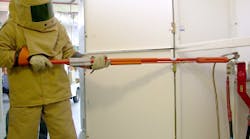Personal protective grounding/bonding (PPGB) techniques provide shock protection for electrical workers working on de-energized equipment. If done correctly, PPGB is by far the most effective means of protecting workers from electrical shock. If done incorrectly, however, it can precipitate arc flash events of unimaginable magnitude.
PPGB is especially important for high-voltage (HV) electrical workers, because equipment can become energized remote from the work location due to switching errors or through induction. In fact, HV circuits can induce voltage and current on conductive surfaces even several yards away from energized conductors.
PPGB equipment
This type of equipment is actually a system of connections, in that there are a number of points where the various components of the grounding cables must connect to the system to be grounded and to each other. It is vitally important to recognize that the grounding system is only as good as the weakest connection. In other words, having high-quality grounding cables but undersized grounding heads will render the system ineffective in protecting workers. There are a number of key concepts to remember when selecting PPGB equipment, including:
Grounding heads — The grounding head is the only connection between the grounding system and the electrical circuit on which work is to be performed. Like grounding cables, the grounding heads must be rated to withstand the available fault current for the duration of the fault event. The data in the Table identifies the withstand ratings of one manufacturer's grounding products.
Grounding electrodes — The grounding electrodes are the other end of the grounding system in that the electrode provides the physical contact with the earth. There are many different ways to connect to the earth. On metal-enclosed power switchgear (MEPS) the connection to the earth is usually through a grounding bus, which is a metal bar that is, in turn, connected to another grounding electrode. Care must be taken to ensure the grounding bus is effectively connected to the earth via an effective grounding electrode.
Voltage testers — You must perform a 3-point test on any circuit to be grounded prior to installing protective grounds. There are several different types of voltage detectors you can use for this task. Regardless of the type of tester used, the main point to remember is that the meter must be properly rated for the voltage of the system on which it will be used.
Grounding mats — Grounding mats are used in PPGB to place workers at the same potential (i.e., voltage) as the equipment on which they are working. The grounding mat is essentially a tarp with aluminum strands braided into it in a crosshatched pattern. The aluminum is connected to a “node” on the edge of the mat, which allows for a connection that is then connected to the grounding conductors of the system on which work is to be performed. The aluminum is only installed on one side of the mat, so that side must obviously be facing up — to ensure the worker is standing on the aluminum grid.
Grounding cables — Grounding cables are responsible for providing a low-impedance path for fault current to flow on a properly grounded circuit. The conductors must be made of multi-stranded copper and can be no smaller than 2 AWG. The primary considerations when selecting grounding cables is their withstand rating for fault current and their length. The Table lists the withstand ratings of typical sizes of grounding cables.
An important point to note in the Table is that the withstand ratings are a function of fault duration. Note that the longest duration listed is ½ sec. As previously discussed, the energy released in an electrical fault is so intense that the electrical system can only withstand it for a fraction of a second. Therefore, anything that is done to the OCPDs that would cause them to retard fault clearing should be avoided, if possible. For example, some workers will install slightly larger fuses when troubleshooting a faulted circuit when they suspect that the reason for the service interruption was overload. However, by “up-sizing” the fuse, they actually increased the amount of current that will flow, should the circuit be faulted again — and the duration of the fault will also increase. The combination of increased current flows with increased duration may well exceed the withstand ratings of the grounding cables, which will melt, leaving the workers exposed to shock hazards on the circuit.
The final point to remember about selecting grounding cables is to keep the length of the cables as short as possible. When any circuit conducts high current flows, strong magnetic fields develop that cause the cables to try to whip violently in response to the attractive or repulsive magnetic fields between the phase conductors. This whipping motion can cause the grounding cables to move back and forth several times in 1 sec, which could result in severe physical trauma to anyone in the vicinity of the cables.
Installation and removal procedure
The basic steps involved in the installation and removal of PPGB equipment is as follows:
-
De-energize the electrical equipment by isolating all possible electrical sources to the equipment.
-
For HV systems, it is a requirement to get a “visual open” in the circuit, such that the worker can visualize an air-gap in the switches used to isolate the circuit. This can be achieved either by opening a solid-blade switch that can be visualized, “racking out” a circuit breaker by removing it from contact with an electrical bus or any other means that positively separates the electrical contacts in an energy isolating device.
-
Follow normal lockout/tagout (LOTO) procedures per 29 CFR 1910.147 and 29 CFR 1910.269 (D &N).
-
It is required to perform a 3-point test with a sensitive voltage testing devices to verify a zero energy state. A 3-point test consists of testing the voltage tester on a known energized source to verify it is working properly (Test No. 1). Then, test the circuit on which work is to be performed (Test No. 2). Finally, test the voltage tester on the same energized source as was used in Test No.1 to verify the tester is still working properly (Test No. 3). Examples of sensitive voltage testing devices include “proximity” testers, such as glow sticks (similar to light pens), tic-tracers (they make a sound), or direct-reading HV voltmeters.
-
One of the most important steps in the grounding process is to properly clean the conductors before connecting to them. This task is performed using a wire brush that is connected to an insulated stick. Wire brushes come in many different styles to accommodate the many different types of equipment that must be grounded. The main point to remember is that you must remove all oxidation on both the phase conductors and grounding electrodes before attaching grounding cables to them.
-
As is the case with most of electrical work, grounding cables must be installed and removed in a specific order. Always connect the grounded end of the grounding cables first. Next, make connections to the phase conductors. When finished with your work, remove the grounding jumpers in the reverse order. Caution: There have been fatalities when workers attempted to move or remove the ground connections while the jumpers were still connected to the phase conductors.
Furthermore, the cables must be placed only at proper points in the electrical system to ensure they perform as expected, should the equipment become energized. Many arc flash accidents have occurred when workers improperly applied grounding cables and the systems became energized.
The techniques for grounding also vary by the types of systems on which work is being performed. For example, the procedure for installing grounds in a substation with exposed overhead conductors is quite different from installing grounds in an MEPS lineup sitting in an industrial facility.
MEPS techniques
For MEPS installations, it's necessary to use a grounding mat to create an equipotential plane. A grounding mat is especially constructed to be conductive rather than an insulator, such as a rubber mat. Although the grounding mat protects the worker standing on it, it represents a potential hazard to anyone stepping on or off of the mat. Should the system to which the grounding mat is connected become energized, a difference of potential (voltage) will likely exist between the mat and the earth in the vicinity of the mat. Although the probability of the system becoming energized while a worker has one foot on the mat and one foot on the earth is quite remote, it warrants mention here, because it's a legitimate hazard. Suffice it to say that care should be taken not to work on the grounded equipment, unless the worker is standing completely on the grounding mat.
The worker's body position is also important, so care should be taken to assume a position where the door of the enclosure shields the worker from an arc blast (should one occur while installing grounds). If the door opens to the left, for example, the worker should install the first ground on the left-most conductor, then ground the center conductor, and finally the right-most conductor. Obviously, the process is reversed if the door to the cabinet opens to the right. The Photo above shows a worker assuming a safe body position when installing protective grounds on MEPS equipment. There are a few important practical points to understand at this point.
-
The system is not safe to touch until all three phase conductors are effectively bonded and grounded.
-
The grounding cables should be laid out on the floor such that the worker can pick them up with the loop stick without touching the conductors (if possible).
-
The connection to the neutral or grounding conductor must never be removed until the grounding jumpers have been removed from all three phase conductors/nodes.
Additional recommendations
Here are some other recommendations to follow that help increase the odds of performing PPGB safely at most facilities.
Ensure only qualified electrical workers install grounds — Typically, electrical workers must acquire specialized training under qualified supervision before being allowed to install grounds. Workers should demonstrate proficiency in both technical knowledge and proper grounding techniques before they are allowed to act as the lead person on this type of job.
Consult arc flash hazard analysis studies prior to grounding equipment — Arc flash hazard analysis studies and equipment labels reveal the SCC values and incident energy (heat) levels at the proposed work location. This information allows the worker to adequately size their grounding cables for the job at hand and wear the proper level of flame-resistant clothing.
Use written checklists for HV switching/grounding — Use of a step-by-step check sheet will help ensure that the proper switching sequences are followed and keep a log of grounding cables installed, which goes a long way in preventing workers from accidentally re-energizing previously grounded circuits.
Disable reclosing relays on circuits to be grounded — Any circuit that includes a reclosing relay must have that relay disabled before any switching or grounding occurs on the subject equipment. The reclosing relays may be physically disabled on the switch itself (mostly in overhead or substation installations) or the relay may reside inside the substation relay house along with the other relays.
Exceed minimum safety standards when needed — There may be times when it's prudent to wear HV rubber gloves or take additional safety precautions even after protective grounds have been installed.
Adopt a “think twice, act once” methodology — Hazards Associated with Grounding illustrates how omitting a single step (i.e., failing to take a voltage reading) in the grounding procedure can result in a fatality. Clearly, HV work exerts a severe penalty on anyone who fails to completely follow safe work procedures.
Use a “buddy system” when grounding equipment — It may be prudent work practice to assign a team of two qualified electrical workers to perform PPGB. The second pair of eyes may catch a missed step in the process. In addition, the second person may serve as a rescuer if something unforeseen occurs. The second person should also assume a position outside the arc flash protection boundary, so that he will not be injured in the event of an arc flash.
The use of PPGB techniques for HV work is by far the most effective means of protecting electrical workers from shock hazards. When properly installed, electrical workers can feel secure that they will be protected even if the circuitry on which they're working should become energized for any reason. However, the real danger of initiating an arc blast also comes with PPGB — so only highly skilled electrical workers should be allowed to install temporary grounds.
Kolak is president of Praxis Corp., a firm specializing in electrical engineering and electrical safety training based in Granbury, Texas. He can be reached at [email protected].
Sidebar: Hazards Associated with Temporary Grounding
The most significant hazard associated with temporary grounding is the potential for generating an arc blast when attempting to install the grounding cables. This usually occurs in conjunction with a human error, because, if proper procedures are followed for testing the circuits, the probability of the circuit becoming energized while the grounds are being installed is remote. However, many workers have mistakenly installed grounds on energized circuits as the following case study from an actual accident illustrates.
A high-voltage (HV) electrician was tasked with performing maintenance on a 7,200V/12,470V circuit in an industrial plant, which was fed by metal-enclosed power switchgear that featured six separate switches (configured as shown in Photos A and B). The electrician was to switch out and ground Switch No. 2 for the work at hand. He correctly identified Switch No. 2, opened it, and racked it out. He then installed his personal lock and tag and closed the front door to the switch. His next task was to go around the backside of the switchgear lineup to install the grounds, because the conductors connected to HV switches were located on the backside of the switchgear.
His fatal mistake was that when he walked around the right side of the switchgear lineup and counted two bays in, he was actually counting from the wrong end of the switchgear lineup (click here to see Figure). He opened the gear and — without making the required 3-point voltage test — attempted to install grounding jumpers on the energized conductors of Switch No. 5. The ensuing arc blast was so severe that the heat released actually melted his hard hat. His burns were exacerbated because the HV switchgear was fed by a recloser, which is a device intended to automatically reset itself (i.e. “reclose”). In fact, the recloser operated a total of three times. So the worker actually suffered three arc blasts as the circuit repeatedly re-energized itself.
The accident scene was horrific. The flash associated with the fault was so intense that the outline of the electrician's body was burned into the wall some 6 ft behind where he was standing. He received third and fourth degree burns to the majority of his body and died three weeks later in the hospital.
This sort of accident is surprisingly common. It illustrates one of the rather unique issues associated with HV work, namely that HV switches sometimes have the actuating mechanism located some distance away from the place where temporary grounds are installed. This increases the possibility of circuit misidentification. This configuration is commonly found in electric utility substations or locations where switches may be controlled with supervisory control and data acquisition (SCADA) systems.
The other common accident associated with temporary grounding is that workers sometimes forget to remove grounding cables that they personally have installed. While this may seem like an incredibly careless mistake, it happens with much greater frequency than you might expect.







